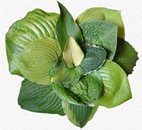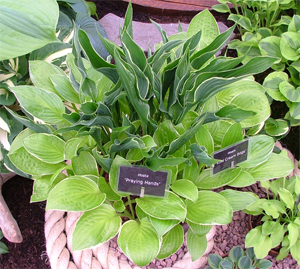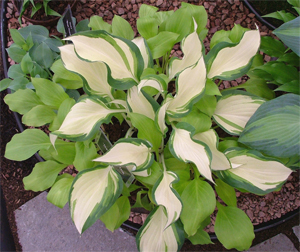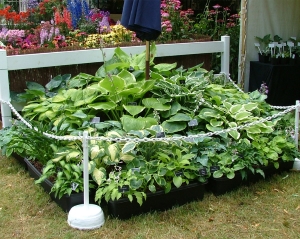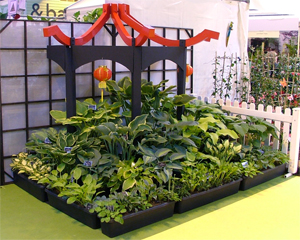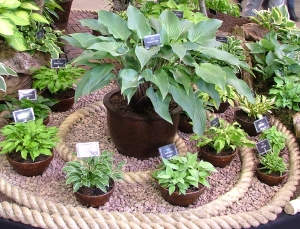Using containers
This is perhaps the most popular way of growing hostas,
especially miniature varieties, which have become very popular over recent
years. There are plenty of excellent reasons to use containers and some
drawbacks, which we hope we have covered with some handy hints...
Watering
The
main issue with growing plants in containers is their need for regular
watering. Using shallow dishes or trays filled with water, to stand
your pots in, takes the guesswork out of doing this. The plants
will only take up what they need, depending upon how much moisture
they transpire through their leaves.
We use trays at the nursery, which are filled through the shade
netting when it rains. Shallow trays avoid the danger of the pots
sitting in too much water. As long as the crowns of the plants are
well clear of the water level, this will work wonderfully.
Pest control
Many gardeners swear by container growing to help prevent pest damage.
However, you must remember that although snails prefer decomposing,
smelly vegetation they are are lazy feeders, so will eat your hosta
leaves if that is the only food source to hand. |
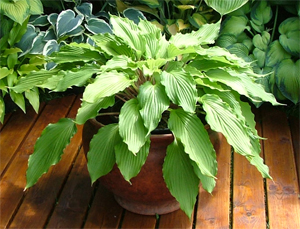 H.
'Shimmy Shake' at
Gardeners' World Live 2011. The pot displayed the habit of the
plant to great effect.
H.
'Shimmy Shake' at
Gardeners' World Live 2011. The pot displayed the habit of the
plant to great effect. |
 |
To avoid this, stand
your pots in shallow dishes or trays and keep them topped up with
water - snails cannot cross water as they need air to breathe. Snails
will climb anything so try to avoid placing your pots up against
walls & fencing and under overhanging shrubbery.
At the base of the pots, in the coolest shade place
a small jar on its side with a teaspoon of slug pellets in it. This will
attract any snails wandering around your pots in for a feed. Using the
jar is essential to keep the pellets dry and the active ingredient sufficiently
pungent to attract the snails - more
details here. |
For products and ideas for plant
and garden accessories, why not visit the Horticultural Exhibitors'
Association website for accredited suppliers of all manner of
garden sundries - HEA Specialisms |
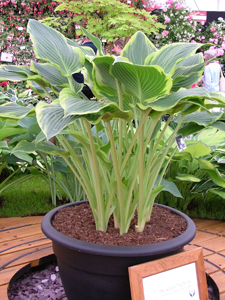 H.
'Yellow River' at
Gardeners' World Live 2010. This variety would have needed re-potting
in a much larger pot at the end of that particular season.
H.
'Yellow River' at
Gardeners' World Live 2010. This variety would have needed re-potting
in a much larger pot at the end of that particular season. |
Size of plant
to use
Some larger varieties will only appreciate being pot-grown whilst
their root systems are immature, unless you have the kind of enormous
urn seen gracing the grounds of some our stately homes. If it appears
your plant is no longer growing, and it hasn't yet reached it's
mature dimensions, it is probably pot-bound. Some of our giant varieties
will only produce a handful of leaves in a 15-20 litre pot because
the root system is so large. If your hosta produces flower spikes
too early, especially without surrounding foliage, this is an indication
it may be pot-bound. Chop off the flowers and re-pot, or divide, the
plant - more
details here.
If you do need to re-pot a particularly pot-bound plant then we
suggest turning the pot onto it's side and hosing out the contents.
This will not damage the plant - indeed it will help the removal
of the soil and enable you to see how best to divide the plant.
It also mitigates the risk of a hernia, and any damage to the pot.
Some older varieties do seem to prefer being ground grown, especially
if they are slow growers such as those from the H .'Tokudama' branch of the genus. But even these will do well
in a pot. |
If any of our ideas inspire you,
don't forget you can select specific plants using our ' search' page. Simply click on the dominant leaf colouring you
desire and those varieties with that leaf colouring are listed
in order of size, with an indication of the flower colour too. |
Getting to grips with your garden
Container growing can be very useful if you are experimenting with layouts
and exploring the benefits of different locations within your garden.
If you are unsure of how a plant will look in a specific location then
use a pot of the first year or two before committing the plant to the
ground. Some varieties would benefit from being container grown for a
couple of years before planting out if their root systems are more fragile.
It will help them to bulk up before they have to argue with more established
plants for nutrients and water, etc. Using containers can help get plants
established whilst you improve the growing conditions in your garden,
if the ground is improverished, compacted or has suffered flooding, etc.
Containers are very useful to help raise your plants higher in the garden,
in much the same way as a raised bed. With all the flooding problems across
the UK this year, many gardeners are looking to find ways to mitigate
future losses of precious plants, and this is a good way to do this. Indeed
the Gardeners' Question Team panel recently advocated the use of raised
beds for growing just about anything when they began receiving lots of
queries about how to avoid the damage caused by excessively wet conditions.
Raised beds can be a lot of work, especially if you are only looking to 'grow on' your plants - how about using an old ladder? The image opposite shows miniature varieties on a couple of step ladders, which looked lovely at Harrogate Spring in 2016. |
 |
Combination planting
Planting more than one variety in a pot can be very effective, see the
photos below. It is an easy way to experiment with colour combinations
and habits. H. 'Praying Hands' is great to use in pots because
it has an upright habit which allows you to plant around it with any number
of smaller, lower-growing varieties. Lime greens can look a little lost
in general planting schemes but come to life when planted with much darker
or lighter colours in a pot. Another particularly good combination is H. 'Dancing in the Rain' and H. Sweet Tater Pie'...
The bowl of miniature varieties, in the image below,
can be a good place to start such varieties off. Some of the miniatures
are so small they would simply get lost planted in the ground and some
of them have such fragile root systems they need a grittier medium in
which to grow. Good root to soil contact is particularly important for
such plants to enable transfer of moisture and nutrients.
Many
of our customers were inspired to do something similar with their
miniatures and place them on garden tables as arrangements. This
is also a good idea as they would benefit for the shade of an umbrella
and are less likely to suffer snail damage being placed up off the
ground. It is perhaps more important you do not over, or under,
water miniatures, so stand your planted bowl in a shallow saucer
topped up with water.
One customer asked us for recommendations of miniature varieties
to edge a 6" deep gulley around the base of a newly constructed
conservatory.
Edging the base of a building with plants is a lovely idea but the
soil beside a building can be a tough environment for any plant
to flourish in. This is why you see so many tougher, often evergreen,
shrubs used for this purpose.
Our recommendation was to use small varieties rather than miniatures
and to plant these in narrow troughs. |
 |
|
This would give more soil
space for the plants to grow into and allow the plants to be raised
above the level of the paving. This would also allow the customer
to place those all important little jars every so often, underneath,
or at the back of, the troughs to prevent pest damage.
There are some lovely small varieties which would
bulk up quickly and create a beautiful feature. We used to use large troughs
to edge our displays when we have had selling spaces in plant malls/villages
at shows:
|
|
|
Hampton Court 2008 |
|
Gardeners' World 2009 |
Plastic containers are good to use because they
are not so heavy to move around. In our displays we tend to use terracotta
pots, which we paint to create different effects. Troughs are also good
if you wish to edge an area, particularly if there is a lack of soil
to plant into, for example, around a conservatory or greenhouse.
Just let your imagination go wild and make use of anything you might
have to hand. Over the years we have used a wide range of hard landscaping
elements to show just what you can achieve, from bog oak to blue glass
chips. Indeed, you can make a lovely feature using simple hard-landscaping
elements such as coloured shingle, irrigation pipe or rope - below are
a couple of our exhibits from 2012:
|
|
|
Malvern Spring 2012 |
|
Harrogate Autumn 2012 |
Statement plants
During 2013 and 2014 we experimented with displays,
which incorporated natural planting with occasional containers placed
to enhance the overall designs. These displays have succeeded in highlighting
the plants we used in the containers to such an effect that often the
very same varieties used in the naturally planted borders were completely
overlooked.
Two very good examples of this were H. 'Deanes Dream', above
right in the centre of the rope spiral, which caught everyones attention
in the pot but none in an earlier display, where it had been part of a
border.
The other is H. 'Cold Heart' - opposite, which we have exhibited several times.
The first time was at Malvern Spring in 2011, as part of the inner border
of the pathway through the stand, where it has to compete with other,
more colourful planting and I even neglected to include it in my photographs.
When we popped it into a container for the Malvern Spring show in 2013
it stole all the attention, and we sold out during the first morning of
the show. |
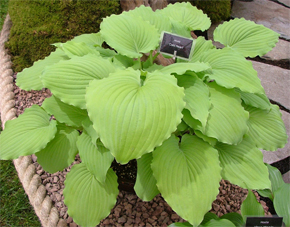 |
That was a good lesson in plant placement.
Some varieties look better in
a mixed border, whilst some in pots and this is largely down to experimentation.
Don't ever consider that a hosta, once planted, must stay where it is.
If you feel it would better exhibit its qualities in a different spot
then move it, or pop it in a pot and see where it does best - this is
the beauty of container-based gardening.
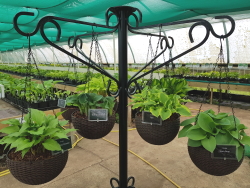
Hostas in hanging baskets |
Hostas in hanging baskets
This is a particularly good way to grow miniatrue and small cultivars as it is much easier to see the plants when elevated. We recommend using plastic hanging baskets rather than coir lined as they are better able to retain moisture. Watering once a week should be sufficient. If you only have coir lined then pop an additional plastic lining inside the basket, around three-quarters of the way up the sides to act as a reservoir. You will need to pierce the plastic so the basket will still drain.
For a practical guide, watch our video. |
The importance of the space around a plant.
As any artist will confirm, the space around a subject can be as important as the subject itself. Using this idea we have refined our container displays to add form and texture to the spaces the containers occupy.
In 2015 and 2016 we used circular discs to isolate containers as a feature. We have made use of shallow, oval pots, round a central container to form a stylised flower shape. Using miniature and small varieties in these petal pots creates a layered effect. The deck is edged with black rope and black aquarium gravel gives texture to the surface. The black rope and gravel serve the purpose of isolating the group whilst drawing the eye to the circular, flower-shape design. |
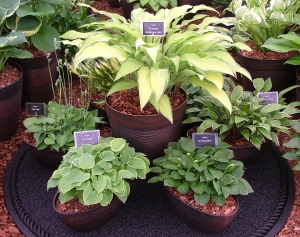
Petal pots underneath a central plant at Hampton Court 2015. |
This group would appear more distinct at ground level rather than elevated on a display platform. If you did something similar in your garden, recycled tyre chips would probably be a better bet than aquarium gravel as a textured surface.
Coordinate the look
A great way to display containers is to select similar shapes in different heights, or simply all the same shade.
The display opposite does both, the containers are all the same colour but vary in height and shape. You don't have to splash the cash either, these are not copper pots but plastic.
If you have a mish-mash of pots in your garden shed, you could opt to paint them to create a similar look.
|
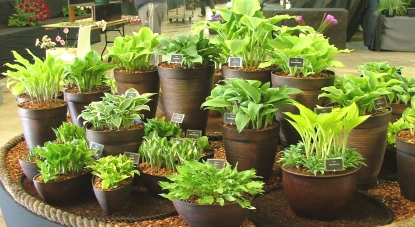
Harrogate Spring 2015 |
|

